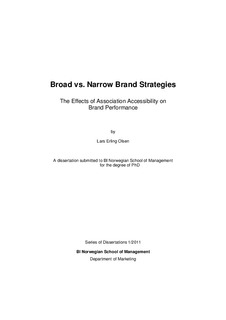| dc.description.abstract | The purpose of this dissertation is to investigate whether brands pursuing a narrow brand strategy perform better than brands pursuing a broad brand strategy. Specifically, the dissertation asks whether associative strength influences a brand’s ability to fight off new competitors (protective performance) and to enhance the evaluation of brand extensions from that brand (growth performance).
This dissertation predicts that limiting the number of diagnostic brand associations for brand A (i.e., narrow brand strategy), increases the associative strength, measured as the accessibility of a target association (measured as response time latencies in milliseconds). Next, the increased accessibility of diagnostic associations would positively influence brand performance. Firstly, if brand A’s associative strength is increased, brand A will more easily resist competition from brand B. And secondly, an extension of brand A into a new product category, in which the fit between the brand extensions and brand A is based on the target association, would be more favorably evaluated. In essence, if brand A pursues a narrow brand strategy, it will perform better. Two studies were conducted in a computer lab to test these predictions.
Study 1 and 2’s results were further extended in a third study. The results of these studies have several theoretical and managerial implications. First, the results contribute to branding practice by providing insight into how managers should focus their branding efforts. Specifically, the results show that a brand focusing on associative strength with a limited associative network (i.e., narrow brand strategy) will perform better than a brand with a large number of associations (i.e., broad brand strategy). Second, the dissertation applies for the first time the theory of the fan effect to branding research. Future studies could benefit by utilizing this theory on a range of different branding problems. Third, the dissertation also contributes to the psychology literature by studying how manipulating the ix fans (i.e., number of associations) of a memory object affects other memory objects.
The managerial implications of the dissertation are also important. First, the results point to the importance of consistent brand management. Second, the dissertation introduces response time latencies as a measure of associative strength in brand management. This measurement technique is well known in psychology, but until now most practitioners have used qualitative consumer interviews in measuring brand associations, labeling as strong associations those associations that are mentioned most frequently or first. | en_US |
